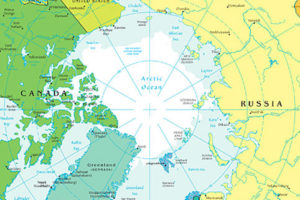Arctic Winter ‘Warmest On Record’

(Article ©2018 RFE/RL, Inc., Radio Free Europe/Radio Liberty – rferl.org – March 7, 2018 – also appeared at rferl.org/a/arctic-winter-warmest-on-record-us-russian-scientists-report/29084098.html)
The winter of 2017-18 was the warmest on record for the Arctic, U.S. and Russian scientists have reported in separate studies.
The U.S. National Snow and Ice Data Center reported on March 6 that the Arctic winter during December, January, and February averaged 4.9 degrees Celsius warmer than normal.
As a result of the extraordinary warmth, ice on the Arctic Ocean and other seas that cover the top of the globe hit a record low for this time of year, the U.S. scientists said.
In February, Arctic sea ice covered 13.9 million square kilometers, about 160,000 square kilometers smaller than last year’s record low, the data center said.
Russia’s weather service, the Federal Service for Hydrometeorology, also reported on its website on March 5 that temperatures in the Arctic region were four to eight degrees higher than normal, according to the Russian state-run news agency TASS.
Because of the unusually warm Arctic temperatures, the winter season was one of the three warmest ever experienced by Russia, TASS reported, citing the Russian service.
The U.S. scientists said it’s been so unusually warm that the land weather station closest to the North Pole — at the tip of Greenland — spent more than 60 hours above freezing in February.
Before this year, scientists had seen the temperature there rise above freezing in February only twice, and fleetingly.
While weather systems played a role in reducing sea ice and stoking warmth, “climate change is the overriding thing,” Walt Meier, a scientist at the data center, told the Associated Press.
“When you have warmer temperatures, you are going to melt more ice and it’s going to grow more slowly,” he said.
Based on reporting by AP and TASS
